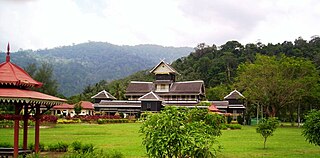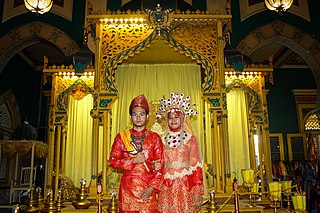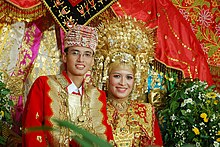Matrilineality is the tracing of kinship through the female line. It may also correlate with a social system in which each person is identified with their matriline, their mother's lineage, and which can involve the inheritance of property and titles. A matriline is a line of descent from a female ancestor to a descendant of either gender in which the individuals in all intervening generations are mothers. In a matrilineal descent system, an individual is considered to belong to the same descent group as their mother. This ancient matrilineal descent pattern is in contrast to the currently more popular pattern of patrilineal descent from which a family name is usually derived. The matriline of historical nobility was also called their enatic or uterine ancestry, corresponding to the patrilineal or "agnatic" ancestry.

Minangkabau people, also known as Minang, are an Austronesian ethnic group native to the Minangkabau Highlands of West Sumatra, Indonesia. The Minangkabau's West Sumatera homelands was the seat of the Pagaruyung Kingdom, believed by early historians to have been the cradle of the Malay race, and the location of the Padri War.

Negeri Sembilan, historically spelled as Negri Sembilan, is a state in Malaysia which lies on the western coast of Peninsular Malaysia. It borders Selangor on the north, Pahang in the east, and Malacca and Johor to the south.

The Undang Yang Empat are the ruling chiefs or territorial chiefs who still play an important role in the state of Negeri Sembilan, Malaysia, namely in the election of a new Yang di-Pertuan Besar. The name is believed to be derived from the Malay word undang-undang meaning "law".

Seri Menanti is a town, a mukim and a state assembly constituency in Kuala Pilah District, central Negeri Sembilan, Malaysia, located 33 km east of the state capital city of Seremban and 14 km southwest of Kuala Pilah. It is the royal capital of the state of Negeri Sembilan and houses the seat of the Yang Di-Pertuan Besar of Negeri Sembilan or Yamtuan Besar, the ruler of the state of Negeri Sembilan. The royal palace is known as Istana Besar.

Adat is a generic term derived from Arabic to describe a variety of local customary practices and traditions deemed compatible with Islam as observed by Muslim communities in the Balkans, North Caucasus, Central Asia, and Southeast Asia. Despite its Arabic origin, the term adat resonates deeply throughout Maritime Southeast Asia, where due to colonial influence, its usage has been systematically institutionalised into various non-Muslim communities. Within the region, the term refers, in a broader sense, to the customary norms, rules, interdictions, and injunctions that guide individuals' conduct as members of the community and the sanctions and forms of address by which these norms and rules are upheld. Adat also includes the set of local and traditional laws and dispute resolution systems by which these societies are regulated.
Datuk is a Malay title commonly used in Brunei, Indonesia, and Malaysia, as well as a traditional title by Minangkabau people in West Sumatra, Indonesia.
Matrilineal succession is a form of hereditary succession or other inheritance through which the subject's female relatives are traced back in a matrilineal line.

Rumah Gadang or Rumah Bagonjong "house for the Minangkabau people" are the traditional homes of the Minangkabau in West Sumatra, Indonesia. The architecture, construction, internal and external decoration, and the functions of the house reflect the culture and values of the Minangkabau. A Rumah Gadang serves as a residence, a hall for family meetings, and for ceremonial activities. In the matrilineal Minangkabau society, the Rumah Gadang is owned by the women of the family who live there; ownership is passed from mother to daughter.

Masjid Tanah is a town and parliamentary constituency in northwestern Malacca, Malaysia, bordering Negeri Sembilan across the Linggi River.

Tan Sri Dato' Seri Utama Dr. Rais bin Yatim is a Malaysian politician and lawyer who served as the 18th President of the Dewan Negara from September 2020 to June 2023, 8th Menteri Besar of Negeri Sembilan from 1978 to 1982 and the Member of Parliament (MP) for Jelebu from November 1999 to May 2013.

The Overseas Minangkabau is a demographic group of Minangkabau people of Minangkabau Highlands origin in Central Sumatra, Indonesia who have settled in other parts of the world. Over half of the Minangkabau people can be considered overseas Minangkabaus. They make up the majority of the population of Negeri Sembilan and Pekanbaru. They also form a significant minority in the populations of Jakarta, Bandung, Medan, Batam, Surabaya and Palembang in Indonesia as well as Kuala Lumpur, Malacca, Penang, Singapore and Brunei Darussalam in the rest of the Malay world. Minangkabaus have also emigrated as skilled professionals and merchants to the Netherlands, United States, Saudi Arabia and Australia. The matrilineal culture and economic conditions in West Sumatra have made the Minangkabau people one of the most mobile ethnic group in Maritime Southeast Asia.
Negeri Sembilan Malay is an Austronesian language spoken mainly in the Malaysian state of Negeri Sembilan, including Alor Gajah and parts of Jasin District in northern Malacca, and parts of Segamat District in the northernmost part of Johor. The language is spoken by the descendants of Minangkabau settlers from Sumatra, who have migrated to Negeri Sembilan since as early as the 14th century. It is often considered a variant or dialect of the Minangkabau language; lexical and phonological studies, however, indicate that it is more closely related to Standard Malay than it is to Minangkabau.

Simpang Durian is a small town in Jelebu District, Negeri Sembilan, Malaysia. It is situated about 10 km from the Pahang border and about 130 km from Kuala Lumpur. Simpang Durian is also a popular stopover destination for super bikers from Singapore and southern states of West Malaysia to rest and refuel before proceeding to Genting Highlands.

The Indonesian Malaysians are Malaysian citizens of Indonesian ancestry. Today, there are many Malaysian Malays who have lineage from the Indonesian archipelago and have played an important role in the history and contributed to the development of Malaysia, they have been assimilated with other Malay communities and are grouped as part of the foreign Malays or anak dagang in terms of race. The Malaysian census does not categorize ethnic groups from the Indonesian archipelago as a separate ethnic group, but rather as Malay or Bumiputera.

Minangkabau culture is the culture of the Minangkabau ethnic group in Indonesia, part of the Indonesian culture. This culture is one of the two major cultures in the Indonesian archipelago which is very prominent and influential.

The Minangkabau Malaysians are citizens of the Malaysia whose ancestral roots are from Minangkabau of central Sumatra. This includes people born in the Malaysia who are of Minangkabau origin as well as Minangkabau who have migrated to Malaysia. Today, Minangkabau comprise about 989,000 people in Malaysia, and Malaysian law considers most of them to be Malays. They are majority in urban areas, which has traditionally had the highest education and a strong entrepreneurial spirit. The history of the Minangkabau migration to Malay peninsula has been recorded to have lasted a very long time. When the means of transportation were still using the ships by down the rivers and crossing the strait, many Minang people migrated to various regions such as Negeri Sembilan, Malacca, Penang, Kedah, Perak, and Pahang. Some scholars noted that the arrival of the Minangkabau to the Malay Peninsula occurred in the 12th century. This ethnic group moved in to peninsula at the height of the Sultanate of Malacca, and maintains the Adat Perpatih of matrilineal kinships system in Negeri Sembilan and north Malacca.

Mount Datuk, also known as Mount Rembau, is a mountain situated on the border between Batang Nyamor, Rembau District and Johol, Kuala Pilah District in the Malaysian state of Negeri Sembilan, at the southern section of the Titiwangsa Mountains. At around 884 m (2,900 ft), it is the highest mountain in the district of Rembau.

Marawa is a tricolour flag that consists of three vertical charts that feature the colours of the Minangkabau culture: black, red, and gold. It is not known for sure when this flag was first used, but it was officially adopted as the flag of the Pagaruyung Kingdom since its founding in 1347. This flag was also adopted by other kingdoms of the Minangkabau rantau such as the Inderapura Kingdom. A derivative of the flag is also currently used by Negeri Sembilan, a state in Malaysia with historical and cultural connections with the kingdom.
















